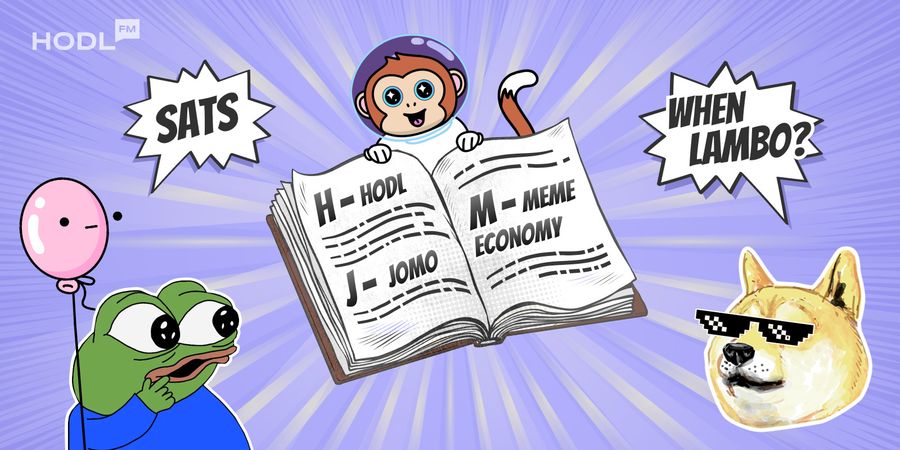Crypto slang is the peculiar argot that has emerged from the world of cryptocurrency and blockchain technology. It’s filled with cryptocurrency terminology that can sometimes appear daunting. Similar to how medical professionals use specific jargon to communicate accurately and quickly, crypto enthusiasts use a vibrant array of terms, abbreviations, and memes. This unique language serves as a marker of insider knowledge, providing a sense of identity and community among its speakers.
The cryptocurrency sector is a complex beast. The underpinnings of blockchain technology, smart contracts, digital tokens, and cryptography are daunting enough. But navigating the crypto community can feel like wandering in an alien land if you’re not familiar with the colloquial dialect, or Bitcoin jargon, as some might call it. So, let’s dive right in!
Crypto Slang Decoded
Cryptocurrency lingo can be broadly classified into several categories: Bitcoin-specific phrases, altcoin and token terms, trading and investment slang, technical cryptocurrency terms, and community or social media language.
Bitcoin-related Terms
Hodl: Originating from a typo in a Bitcoin forum, ‘hodl’ is an acronym for ‘Hold On for Dear Life’. It signifies the resolve to hold onto your Bitcoin investment despite market fluctuations and scary dips. Hodlers aren’t day traders; they’re the ride-or-die supporters of Bitcoin, who hold onto their coins no matter the turbulence.
FUD: This ominous-sounding acronym stands for Fear, Uncertainty, and Doubt. It’s often used to describe intentionally misleading or negative information about a cryptocurrency, primarily intended to bring down its price. FUD is the weapon of choice for those who aim to manipulate investor sentiment to their advantage.
Moon: This term denotes a highly optimistic price target. If a cryptocurrency is ‘going to the moon’, it means the price is expected to rise astronomically. A ‘moonshot’ is an investment with the potential for high returns, despite the associated high risk.
Altcoin and Token Terms
Shitcoin: Not all coins are created equal. A ‘shitcoin’ is a derogatory term for a cryptocurrency deemed worthless because of lack of potential, poor infrastructure, or scammy vibes. While one person’s gold may be another’s shitcoin, it’s wise to be wary of projects universally panned by the community.
ERC-20: In the world of Ethereum, ERC-20 is a big deal. It’s a technical standard for implementing tokens on the Ethereum blockchain. Most tokens issued through Initial Coin Offerings (ICOs) conform to the ERC-20 standard, making it easier for wallets and exchanges to handle various tokens.
ICO: Speaking of ICOs, an Initial Coin Offering is a form of fundraising for crypto projects. It’s similar to an Initial Public Offering (IPO) in the stock market. Investors buy into the offering, receiving tokens or coins in return. While some ICOs have yielded mammoth returns, others have crashed and burned, so careful research is a must.
Trading and Investment Slang
Whale: In crypto lingo, a ‘whale’ is an individual or entity with a significant amount of capital, capable of making market-moving trades. Whales can sometimes manipulate the market to their advantage, leading to sudden price surges or dips.
Pump and Dump: This is a market manipulation scheme where the price of an asset is artificially inflated (‘pumped’) to attract unsuspecting investors. Once the price is high enough, the manipulators sell off their holdings (‘dump’), leading to a sharp price drop and losses for those who bought in during the pump.
Bagholder: A less fortunate character in the crypto saga, a ‘bagholder’ is someone left holding cryptocurrency that has drastically dropped in value. It’s the person who bought at the peak of the pump and didn’t sell off in time.
Technical Cryptocurrency Terms
Blockchain: At its core, a blockchain is a decentralized, digital ledger where transactions are recorded chronologically and publicly. It’s the groundbreaking technology underpinning Bitcoin and other cryptocurrencies, enabling trustless and transparent transactions.
Hash Rate: This is a measure of computational power used in mining and processing transactions on a blockchain. A higher hash rate means more computational power, translating to increased security and faster transaction processing times.
Consensus Mechanism: This is the method by which a blockchain network agrees on the state of the ledger. Different cryptocurrencies use different consensus mechanisms, like Proof of Work (PoW), Proof of Stake (PoS), or Delegated Proof of Stake (DPoS).
Community and Social Media Language
FOMO: An acronym for ‘Fear Of Missing Out’, FOMO refers to the anxiety experienced when one sees a cryptocurrency price skyrocketing and feels the urge to buy in to avoid missing out on potential profits.
DYOR: Standing for ‘Do Your Own Research’, DYOR is a cautionary reminder that each investor should conduct thorough research before investing in cryptocurrencies, instead of relying solely on recommendations or hype.
Shill: To ‘shill’ is to promote a coin or a project, often because one has a personal stake in its success. While some shilling is genuine, be cautious of those shilling coins with little to back up their promotional claims.
Niche Crypto Slang: NFT-related Terms and DeFi-specific Jargon
As the cryptocurrency sector evolves, so does its language. Niche sectors like Non-Fungible Tokens (NFTs), Decentralized Finance (DeFi), and privacy coins have all spawned their own subsets of slang.
NFT-related Terms
Minting: In the NFT universe, ‘minting’ is the process of creating a new NFT on the blockchain. When an NFT is minted, information about the digital asset, such as its ownership and authenticity, is recorded on the blockchain.
Gas Fees: These are the transaction costs on the Ethereum network, payable every time a transaction is processed. These fees can vary, often spiking during times of high network congestion.
Royalties: NFTs have introduced a new model of royalties, where creators receive ongoing payments whenever their NFTs are resold on secondary markets. This royalty mechanism ensures artists continue to benefit from their work’s increasing value.
DeFi-specific Jargon
Yield Farming: Also known as liquidity mining, yield farming is a method to earn rewards by staking or lending cryptocurrency assets. It’s been a significant driver of the DeFi boom, offering potentially high returns to liquidity providers.
Impermanent Loss: This is the potential loss that liquidity providers in DeFi protocols face if the price of their provided tokens changes compared to when they were deposited. The loss becomes ‘permanent’ if the liquidity is withdrawn in this state.
Rug Pull: A ‘rug pull’ is a type of scam in DeFi where developers abandon a project and abscond with users’ funds. It’s one of the risks associated with investing in unverified or new DeFi projects.
Privacy and Security Terms
Cold Storage: This is a security measure where cryptocurrency is stored offline to avoid hacking or theft. Cold storage can involve hardware wallets, paper wallets, or even metal wallets, and is recommended for storing large amounts of cryptocurrency.
Privacy Coin: Privacy coins are a type of cryptocurrency designed to hide transaction details, such as the identity of senders and receivers, or the transaction amount. Examples include Monero (XMR) and Zcash (ZEC).
Onion Routing: A method of anonymous communication over a network, where messages are encapsulated in layers of encryption (like layers of an onion). It’s used by privacy-focused networks such as Tor.
Decoding Crypto Memes and Emojis
The crypto community loves its memes and emojis. They serve as shared cultural touchpoints, often carrying more weight than formal announcements or press releases.
The Dogecoin Shiba Inu: The Shiba Inu, a Japanese dog breed, is the face of Dogecoin, a cryptocurrency that began as a meme but has gained serious traction. The popularity of the Shiba Inu meme has significantly contributed to Dogecoin’s mainstream recognition.
Laser Eyes: This trend involves crypto enthusiasts modifying their profile pictures to have glowing red eyes, signaling their belief in Bitcoin and the crypto movement. ‘Laser eyes’ denote the user’s aim for Bitcoin to reach a price of $100,000.
Rocket Emoji (🚀): The rocket emoji is a favorite among crypto enthusiasts, signaling the belief that a coin’s price is about to ‘rocket’ upward.

The world of cryptocurrency isn’t just about numbers, charts, and lines of code. It’s also a vibrant community with its own unique culture, language, and humor. Understanding crypto slang is key to being an active participant in this world. It’s a dynamic lingo that captures the zeitgeist of the blockchain space – innovative, humorous, and occasionally irreverent.
As the crypto space continues to evolve, so too will its lexicon. Keep yourself updated, and don’t be surprised when new terms emerge from the depths of Reddit or Crypto Twitter. Remember, in the fast-paced world of crypto, language is an essential tool, so ‘hodl’ onto this guide as you navigate the exciting ‘cryptoverse’.

Disclaimer: All materials on this site are for informational purposes only. None of the material should be interpreted as investment advice. Please note that despite the nature of much of the material created and hosted on this website, HODL FM is not a financial reference resource and the opinions of authors and other contributors are their own and should not be taken as financial advice. If you require advice of this sort, HODL FM strongly recommends contacting a qualified industry professional.





